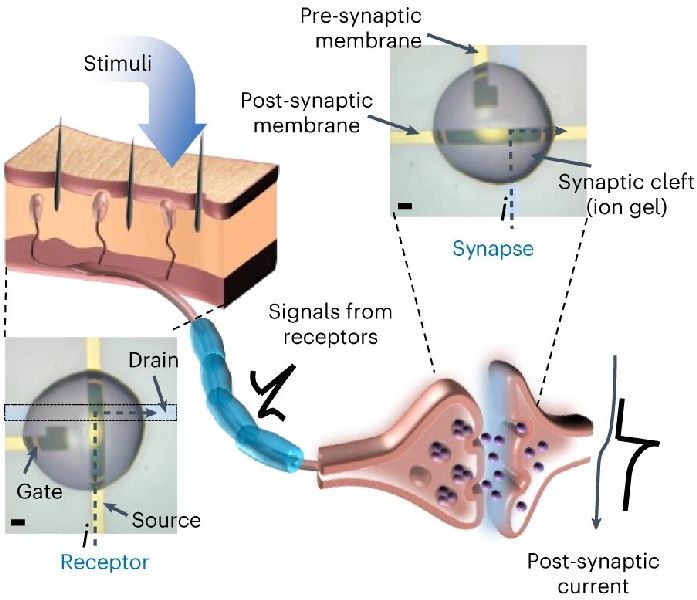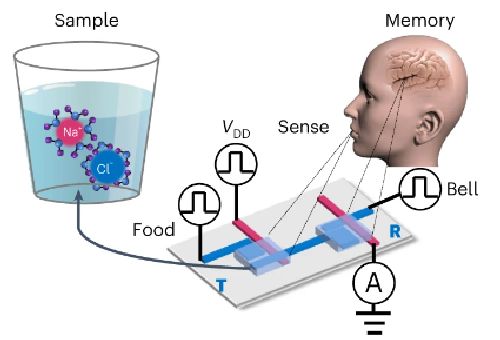
Lately, there has been growing interest in creating brain-inspired hardware for enhancing efficiency of AI models. Conventional hardware architectures are specialized in three specific tasks, which are:
- sensing
- processing
- storing data
Researches across the globe, however, are exploring the possibility of combining these functionalities into a single device. They aim to mimic the parallel and distributed nature of the human brain.
The human brain is incredibly efficient in terms of power consumption compared to traditional computing architectures. Therefore, scientists are looking for ways to emulate the brain’s structure.
A new organic transistor
Researchers at Xi’an Jiaotong University, the University of Hong Kong and Xi’an University of Science and Technology have developed a new organic transistor that can act as both a sensor and processor.
The vertical traverse architecture and the use of a crystalline-amorphous channel with selective ion doping is employed in the fabrication of the organic transistor.
The ability to selectively dope the crystalline-amorphous channel with ions, in the organic transistor, is an interesting feature.
Ion doping can modify the electrical properties of the channel, allowing the transistor to switch between different modes of operation.
The combination offers unique capabilities for reconfigurability.
In addition, organic materials have advantages such as
• mechanical flexibility,
• low-cost manufacturing, and
• compatibility with large-area fabrication processes.
Organic electrochemical transistor
In the current study, organic electrochemical transistor (OECT), developed by researchers can simultaneously function as both a sensor and a processor, added Prof. Wei Ma.
The thinness of OECT makes them promising for applications in smart bioelectronics, including wearable or implantable devices, as well as neuromorphic hardware.
Sensing mode: In the sensing mode, the electrolyte contains ions that are driven by a physiological signal. These ions migrate into the crystal structure of the OECT, causing the channel to be in a low-conductance state.
Importantly, these ions can easily diffuse back into the electrolyte, allowing for reversible sensing.
Processing mode: In the processing mode, the crystal structure of the OECT can “trap” the ions, maintaining the channel in a high-conductance state. This trapping of ions enables the OECT to function as a processor.
The ability to selectively switch between the low-conductance sensing state and the high-conductance processing state is what makes this OECT device unique and efficient.

Techniques behind organic electrochemical transistor (OECT) array
The researchers utilized a series of straightforward and cost-effective techniques and processes to manufacture their organic electrochemical transistor (OECT) array. These techniques enable the potential for large-scale fabrication of the device. The specific techniques employed include thermal evaporation, solution blade coating, thermal annealing, and reactive ion etching.
Thermal evaporation: it’s a technique in which a material is heated to a high temperature, causing it to vaporize and deposit onto a substrate to form a thin film. This technique is commonly employed for depositing metals or organic materials onto the OECT structure.
Solution blade coating: it is a process in which a solution containing the desired organic material is spread onto the substrate using a blade or similar tool. This technique allows for controlled deposition of the material onto the OECT structure.
Thermal annealing: it involves subjecting the device to elevated temperatures for a specific duration. This process is used to enhance the crystallinity, stability, and performance of the organic materials used in the OECT.
Reactive ion etching (RIE): it is a technique used to selectively remove material from the device by bombarding it with ions in a low-pressure plasma environment. RIE allows for precise etching and patterning of the OECT structure, enabling the desired device configuration.
With the help of these techniques, researchers were able to develop their OECT array in a cost-effective manner and on a large scale.
Takeaway
The research looks promising. It represents an important step forward in the quest for more versatile and efficient electronic components that can integrate sensing and processing functionalities.
In addition, the tech may have implications for the design of future organic electronics, particularly in the areas of sensor networks, wearable devices, and Internet of Things (IoT) applications.
Via: Techxplore



